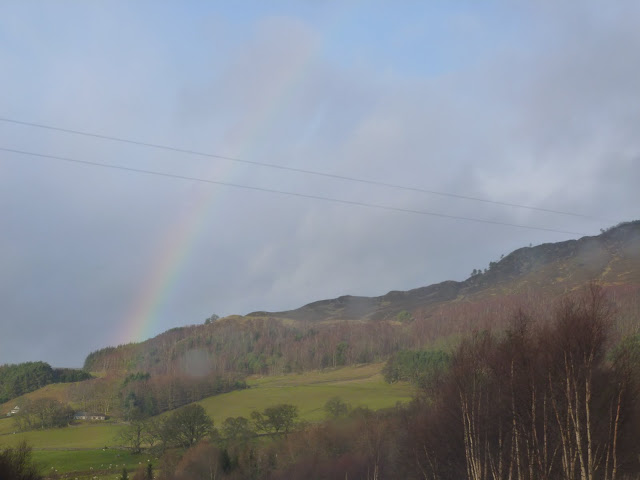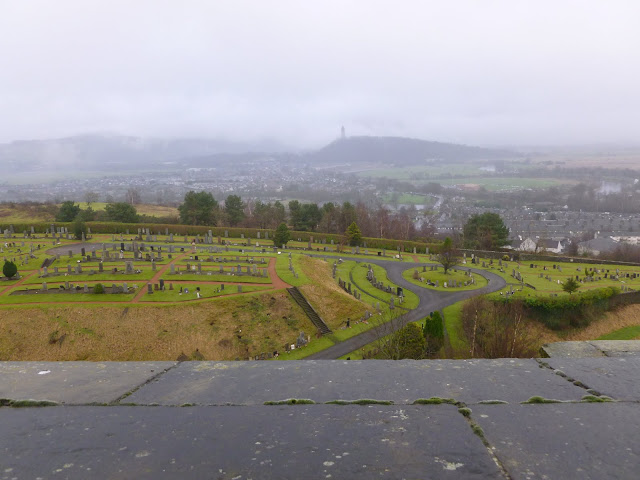As usual, Yuka did a really amazing job of planning our trip. One of the best things she planned was for us to use park and ride instead of having to deal with parking in the city. I'd heard that parking in Edinburgh could be difficult and to be honest one of the things I hate most about cities is parking. Parking sucks... After long days of sight seeing, and an even longer New Year's eve, being able to relax on the bus for a while and not deal with traffic was awesome.
When it came to food, Yuka also did a great job finding us good places to eat. One day we at a nice seafood restaurant called Mussels Inn on Rose St near the city center. We had a tasty lunch of mussels, beer/wine, and fries for 7 pounds, a pretty good deal. Another day we at a very cheap lunch at a small place called Oink which specializes in pulled pork sandwiches. It was also really good.
Realistically, Edinburgh is a lot like other European cities we've been too in that it has old churches, cathedrals, a castle, relatively narrow cobbled streets, and the typical European scenery of double-decker buses, cyclists and trams. Personally, I think what makes Edinburgh interesting is the castle high on the hill in the center of the city. It's pretty interesting.
About the castle, that was one of the first places we visited. The history of the hill being used as a fortress dates back to hundreds of years BCE. The exact date the current stone castle structure isn't known, but is estimated to date back before the 12th century. The castle is the type that spirals around and up the hill with multiple levels separated by individual gatehouses. It must have been pretty difficult to attack..
More history of the castle.
 |
| Edinburgh Castle viewed from the top of the Scott Monument on Princes Street. |
 |
| Entrance to Edinburgh Castle from the end of the Royal Mile. |
 |
| View of Arthur's Seat (hill across the way) from the castle entrance. |
 |
| View from where the 2nd gatehouse was towards the 3rd gatehouse. |
 |
| Technically the 3rd gatehouse of 4 into the castle. |
 |
| Outer courtyard (inner courtyard is further up the hill. |
 |
| More of the outer courtyard |
 |
| View to the West of the castle. |
 |
| Edinburgh castle St. Margaret's Chapel. Oldest building in Edinburgh dating back to the 12th century. |
 |
| View down on Princes street where the Hogmanay street party was and out to the Forth (Bay) of Firth. Notice the Ferris wheel for Hogmanay and train station to the right. |
 |
| Front of the War Memorial / Chapel. Behind this memorial is the inner ward where the Palace is located. |
 |
| Back of the War Memorial from the inner ward. |
 |
| Royal apartment building and where the Scottish Royal Jewels were located. |
 |
| Amazing carvings above the doorway in the Great Hall. |
It took 40 minutes (probably 30 stops) to reach the site. That leads me to another problem with the bus system in Edinburgh. Unlike other places we have been, none of the buses here had signage of the next station nor did the stops have detailed maps showing the stops. After about 20 minutes of not seeing our stop we started to get concerned some nice locals tried helping us out (they didn't know where or what Gilmerton cove was). Finally a guy (with the worst smelling breath I have ever smelt, btw, I almost started dry-heaving) told us where our stop was. Ugh.
About the cove... In the 18th century, a blacksmith named George Paterson claimed to have excavated the entirety of Gilmerton cove in 5 years. Recently, experts have claimed that wasn't possible using 18th century technology and the coves are likely much older. There are multiple theories of why the coves where created stemming from a mining operation digging test shafts searching for coal to bootleggers creating the underground area to illegally distill and distribute whiskey. Another theory I found intriguing is that this place was created as a secret escape from a royal residence half a mile away. There is a collapsed section that goes in the direction of the residence, though excavation has been disallowed since the collapsed area goes directly below a busy road (in several places we saw the actual pavement above...) and would risk collapse of the road. The big problem with the tour was that almost nothing is known of the cove so most things were conjecture. It was interesting that there were distinct rooms and most of them had what appeared to be tables with stone seating areas. That would potentially point towards a history steeped in the illegal consumption of alcohol, but who knows. I would say if you are thinking of going, you may want it to be low on your list of things to see unless you run out of things to do.
 |
| Gilmerton Cove hallway |
 |
| Gilmerton Cove - 1 of 7 distinct chambers |
 |
| Another room in Gilmerton Cove |
The main purpose for us to visit Edinburgh was to participate in the New Year's festivities (otherwise known as Hogmanay). We purchased tickets not only to the New Year's eve celebration, but also to the torchlight procession and a New Year's Eve concert in St. Giles Cathedral (see pic below).
 |
| St. Giles Cathedral where we saw a candlelight New Year's Eve concert. |
 |
| Just after lighting our torch (we gave our other one to a kid who didn't have one) |
 |
| We started right in front of St. Giles. Yuka was having a great time. |
 |
| There were so many people behind us. |
 |
| There were also a lot of people in front of us. |
 |
| I didn't think we were walking slow, but somehow the line in front of us got really, really long. |
 |
| St.Giles before the candlelight concert. |
 |
| St. Giles well-lit |
 |
| More St.Giles. The ceiling was really interesting. |
 |
| This was taken around 11pm, and the crowd is already huge. |
 |
| Amazing view to see the fireworks shot from the castle. |
 |
| I did a poor job of getting a good shot of the fireworks. They were great. |
 |
| More fireworks. |
After seeing the great fireworks display, we hauled-ass to the free bus area and caught the first bus to the airport where we parked. Again, it was nice taking the bus. That pretty much ended our Scotland vacation. It was nice sleeping in the next day...

















